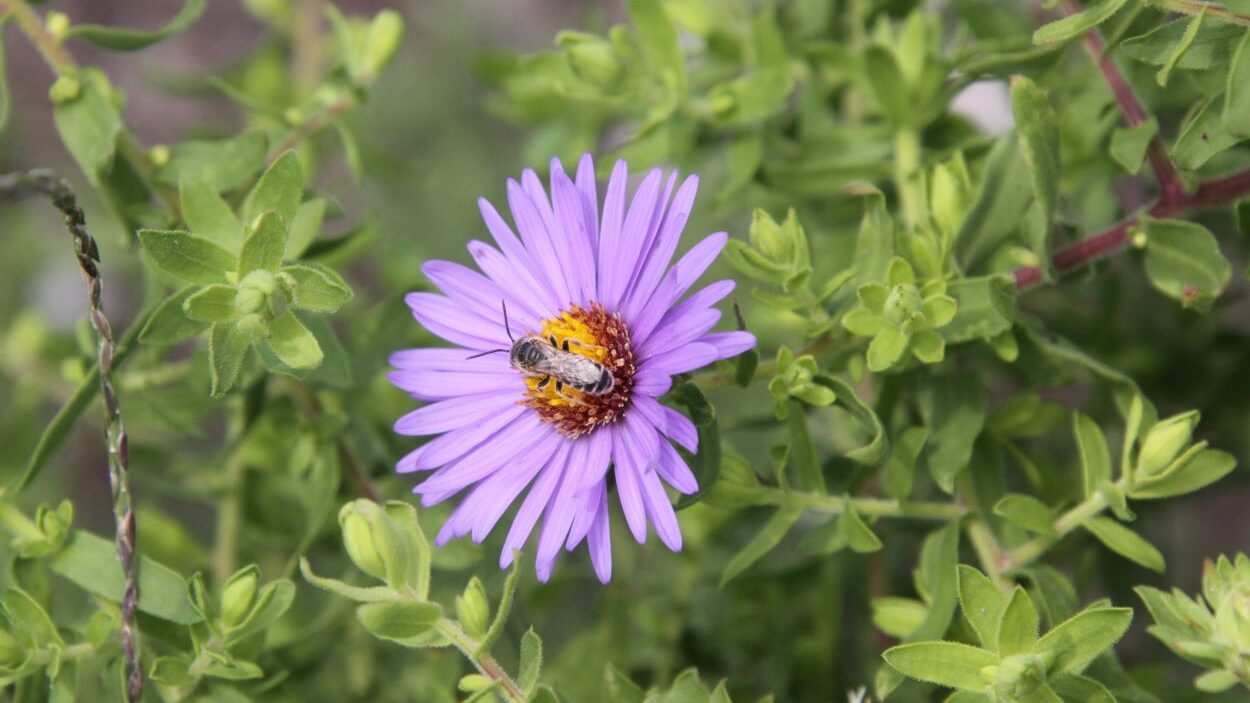Asters are in full bloom at the Arboretum and are brightening up our gardens this fall with many diverse and attractive varieties. Asters are a member of the Asteraceae family and are recognizable by their daisy-like flowers reminiscent of a star shape. Plants in the Aster genus are restricted to those native to Europe and Asia. Asters native to North America belong to two genera, Symphyotrichum and Eurybia. Throughout the Arboretum, you can find over 4,000 specimens of asters representative of all three genera, comprising of over 18 different species and cultivars, with some notable collection highlights below.
Bushy and compact, the heath asters (Symphyotrichum ericoides), found in the Pollinator and Bird Garden, can grow to be 1 to 3 feet tall. Racemes (one-sided dense sprays) feature white, daisy-like flowers with yellow centers. Heath asters attract butterflies and typically bloom in late summer to early fall. The heath aster variety ‘Snow Flurry’ differs from the typical heath aster because they are shorter; they grow 4 to 6 inches tall and spread along the ground to form a dense foliage mat. Their flowers are also white but typically bloom later in the fall from September to October and are prevalent in the Pollinator and Bird Garden.
Blue wood asters (Symphyotrichum cordifolium), a stout plant that grows on smooth upright-arching stems, are located in the Pollinator and Bird Garden. These stems generally reach 2 to 5 feet tall. Pale- to rich-blue daisy-like asters densely adorn panicles atop the stems. The flowers attract butterflies and bloom in late summer heading into early fall.
Another butterfly-attracting aster, New England aster (Symphyotrichum novae-angliae), blooms from August to September and can be found at the Overlook Pavilion. Daisy-like flowers are generally deep pink-purple and are surrounded by rough, hairy leaves. ‘Purple Dome’ is another variety of New England aster. They also can grow 2 feet high, but their shorter petals are a deep royal purple that brighten up our Pollinator and Bird Garden.
Two attractive varieties of aromatic aster (Symphyotrichum oblongifolium), pictured above, sweeten the Pollinator and Bird Garden. ‘October Skies’ features a compact plant with small, deep-blue flowers. When crushed, their blue-green leaves produce fragrance. ‘Raydon’s Favorite’ show off cheerful violet-blue flowers and also have blue-green leaves that are fragrant when crushed.
Bees aren’t the only fuzzy ones in the Pollinator and Bird Garden. Frost aster (Symphyotrichum pilosum) stems and leaves are extremely hairy, hence their other common name, hairy aster. Flowers rise in branching clusters and bloom from August to October. They emerge white and turn reddish-purple with age.
White wood aster (Eurybia divaricata) brightens up our Pollinator and Bird Garden, Children’s Garden, and Hartley Wood. They are a sprawling plant that grows up to 2 feet tall. Tiny but abundant white flowers are arrange in flat-topped clusters. They bloom from August to September and can be distinguished by their unique heart-shaped leaves.
Come out explore this diverse pollinator-friendly perennial this fall. Asters provide a welcome pop of color into October and can even persist after the first few frosts!

